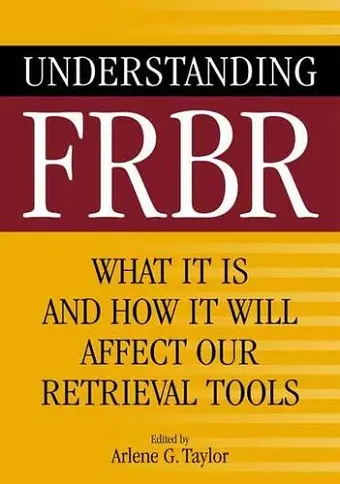Understanding FRBR
What It Is and How It Will Affect Our Retrieval Tools
Format:Paperback
Publisher:Bloomsbury Publishing PLC
Published:30th Nov '07
Currently unavailable, and unfortunately no date known when it will be back

An overview of the FRBR model, and how it can improve access to information through the helpful organization of metadata records.
What is FRBR, and why is everyone talking about it? Is it really going to revolutionize cataloguing? And if so, what form will it take? This book is written for librarians, bibliographic systems designers, library and information science faculty and students, and anyone else who is interested in learning about the Functional Requirements for Bibliographic Records (FRBR) and how following the FRBR model can improve access to information through helpful organization of the metadata records that are surrogates for information resources. Serials, art, music, moving images, maps, and archival materials are just a few of the formats covered. Not for catalogers only!
Understanding FRBR. . . features chapters contributed by leading authorities in the cataloging field. . . . It offers a basic introduction to FRBR, discussions about FRBR, FRAD (functional requirements for authority data), and RDA (resource description and access), and the issues involved in using FRBR in nontraditional library settings such as with cartographic materials and music. Both books are well illustrated and include numerous bibliographical resources.' [Reviewed in conjuntion with FRBR: A Guide for the Perplexed]. * Library Journal *
Understanding FRBR is clearly written, well illustrated (many of the concepts are clarified by very helpful diagrams), and well indexed; additionally, chapters feature extensive bibliographies, many of which provide URLs to the IFLA groups' documents. While it may seem that this book is of interest only to catalogers, the application of FRBR will change the structure of catalog and the systems used to store and display it; therefore, it is an important text for systems librarians, reference librarians, and anybody else interested in the future of the organization and display of bibliographic information. * College & Research Libraries *
The emergence of this textbook is testimony to the breadth and depth of work done to date. It documents much of that work, and provides a good basic introduction to FRBR that is broadly understandable. . . . The relational concepts within FRBR are complicated and can be challenging. This book does a good job of illuminating them in a straightforward manner. It also describes how the application of the FRBR concepts could improve our systems of bibliographic access in very specific ways. . . . For those of us that really want or need to be able to predict the impact that FRBR will have on our work, this is an accessible explanation of the current state of the art. As such it is a real contribution to our understanding. * TechKNOW *
Taylor and her contributors cover FRBR and introduce the reader to FRAD as well. . . . All chapters conclude with current and useful references to further reading and more information. * Booklist *
Arlene Taylor and her compadres don't even try to teach you how to construct a hierarchical record. Instead, they direct their efforts toward showcasing what's possible when digital technology and traditional cataloging practice meet. This is the future of cataloging. * Library Media Connection *
Understanding FRBR is a useful and timely book that brings together recent developments in FRBR and offers several assessments of it. * Technicalities *
No cataloguer, bibliographic systems designer or library and information science lecturers and students should be without this book. It is a useful resource in acquiring an understanding of what FRBR is about and how it will change the way in which cataloguers will think about cataloguing in future. * The Electronic Library *
ISBN: 9781591585091
Dimensions: unknown
Weight: 397g
192 pages